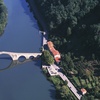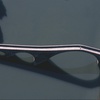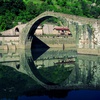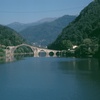Devil's Bridge
Located a short distance from Borgo a Mozzano, the Ponte della Maddalena is a wonderful work of mediaeval civil engineering. The bridge was built with the intention of linking the two banks of the Serchio, so as to connect Lucca not only with the Val di Lima, but also with all the towns located on the left bank of the river.
The work was carried out using the mediaeval "humpback" bridge construction technique, the characteristics of which are particularly pronounced considering the distance it had to span, which was exceptional for its time.
The Maddalena Bridge owes its name to the presence of an oratory with adjoining hospital, on the left bank of the river, but its particular shape and the momentum of the main arch gave rise to legends about its construction. In particular, it was said that, on finding himself behind time with the construction, the architect in charge of the work had invoked the devil to help him to complete the bridge. The pact was signed with blood: in exchange for the conclusion of the work in one night, the architect agreed to the request of the devil to take possession of the first soul to cross the bridge, but did not calculate that as the technician he would have to test it. On inauguration day, however, the architect made a dog cross the bridge first, and so the devil who had been duped had to settle for the soul of the animal. Thereafter, the bridge was called "of the Devil" to commemorate who legend has it was the real architect.
Historical notes
Recent studies have established that of the original structure, dating from the twelfth century, only the wider arc remains, while the rest is the result of successive restorations. The most significant restoration occurred in the fourteenth century, after a full collapse of much of the bridge, with the exception of the main arch. The entire construction was later restored by the intervention of leader Castruccio Castracani of the Antelminelli. In 1898, with the construction of the railway line of the Garfagnana, the first arch placed at the right bank of the river was rebuilt, raising it up so as to allow the passage of trains.












